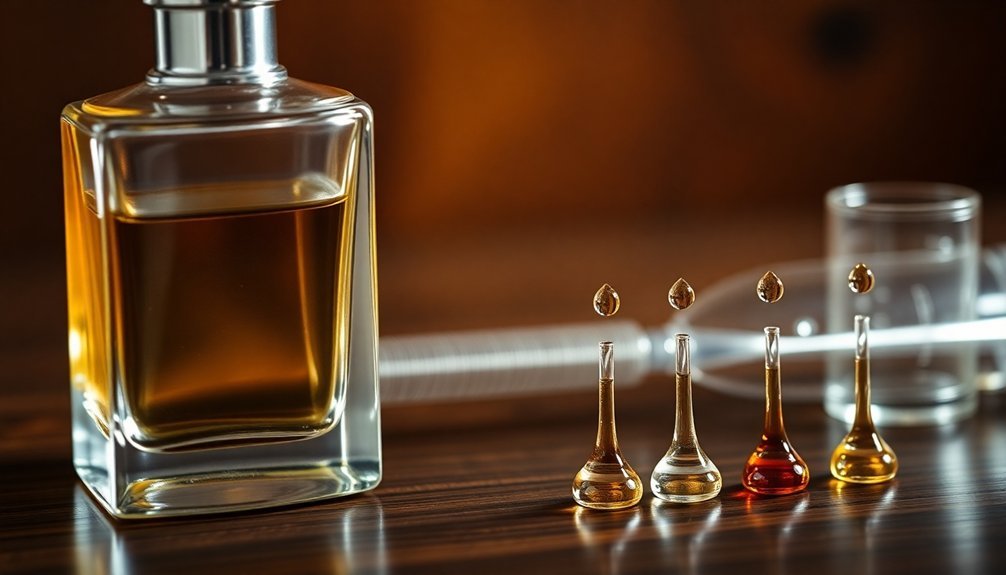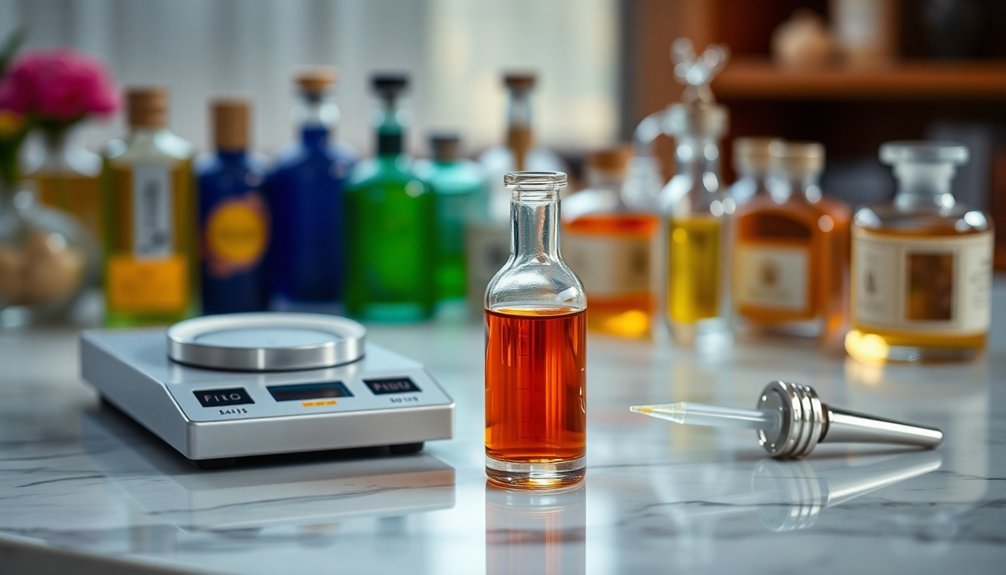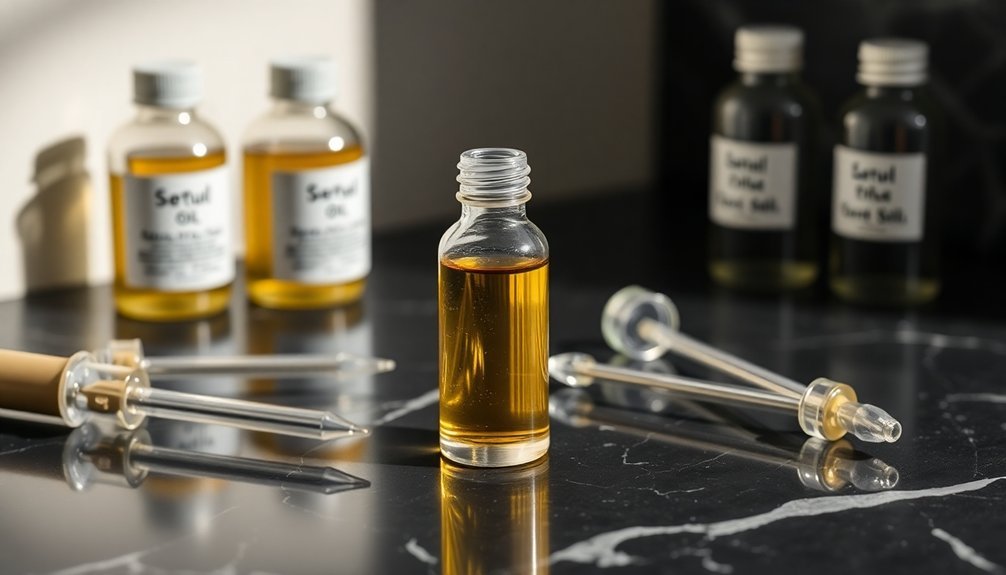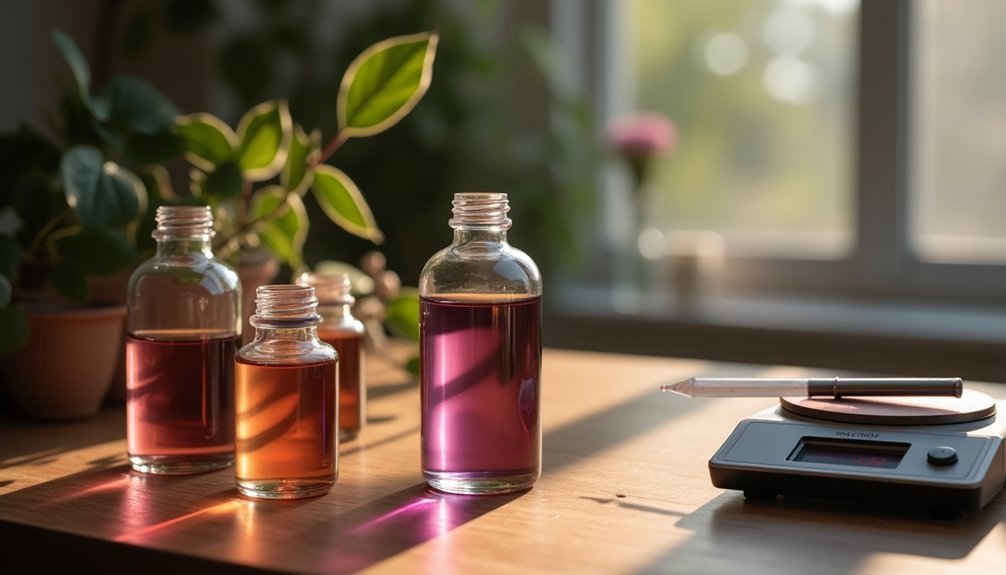To measure perfume concentration ratios correctly, you'll need a digital scale accurate to 0.01g and proper glass measuring equipment. For standard Eau de Parfum (EDP), aim for 15-20% fragrance oils, while Eau de Toilette (EDT) requires 5-15%. Don't rely on counting drops – instead, calculate exact percentages based on your total volume. Follow the classic 30/50/20 ratio for top, middle, and base notes. There's much more to master in perfume concentration measurement.
Understanding Basic Perfume Concentration Types

When choosing a perfume, it's essential to understand the different concentration levels that determine a fragrance's strength and longevity.
You'll find four main types, each with distinct characteristics.
Parfum offers the highest concentration at 20-40% fragrance oils, lasting up to 24 hours with powerful projection. The higher concentration means it is typically sold in smaller bottles.
Eau de Parfum (EDP) contains 15-20% oils and lasts 4-8 hours, making it perfect for special occasions.
Eau de Toilette (EDT) features 5-15% concentration, ideal for everyday wear with its 3-5 hour duration.
The lightest options are Eau de Cologne (EDC) at 2-4% and Eau Fraiche at 1-3% oils, lasting only 1-2 hours and requiring frequent reapplication.
Both are invigorating choices for casual, warm-weather use.
Essential Equipment for Measuring Perfume Volume
You'll need a precise digital scale that measures to 0.01g for accurate perfume concentrate measurements and ratio calculations.
Essential tools include graduated glass measuring columns for small volumes and calibrated glass measuring cups for larger quantities of base oils or alcohol.
Professional-grade beakers, disposable pipettes, and glass stirrers complete your measurement toolkit, ensuring consistent and precise perfume formulations.
Using weight-based percentages for calculations provides more reliability than measuring by drops, which can vary in size.
Digital Volume Measurement Tools
Precision stands at the heart of perfume creation, yet traditional volume measurements like drops can lead to significant formulation errors.
You'll find that drops vary widely in size depending on the dropper, liquid type, and application pressure, making them unreliable for accurate formulations.
Instead, you'll want to rely on digital scales that measure to 0.01g for your perfume ingredients.
While glass measuring cylinders and beakers are useful for larger batches, weight measurements provide better accuracy due to varying material densities.
For professional perfumery, you might consider automated measurement systems that handle filling, rinsing, and drying while measuring multiple parameters simultaneously.
Modern systems require less than 10 mL per testing cycle, making them ideal for precious perfume ingredients.
These systems minimize human error and streamline the process.
Precision Weight Analysis Equipment
The foundation of accurate perfume formulation lies in selecting the right measurement tools. You'll need a precision scale with 0.001g accuracy to guarantee your perfume ratios are exact. While this level of precision might seem excessive, it's vital for consistent results and efficient use of costly ingredients.
| Feature | Requirement |
|---|---|
| Accuracy | 0.001g (1mg) |
| Capacity | 500g minimum |
| Power Source | Mains adaptor preferred |
| Pan Size | 90mm diameter |
| Accessories | Wind shield, calibration weights |
Choose a mains-powered scale to avoid interruptions from auto-shutdown features common in battery-operated models. Your scale should include essential accessories like a wind shield to protect against air currents and calibration weights to maintain accuracy. The 500g capacity will accommodate most perfumery needs while guaranteeing precise measurements of even the smallest ingredients.
Container Calibration Instruments
Accurate volume measurements form the backbone of successful perfume creation.
You'll need reliable container calibration instruments to achieve precise ratios in your formulations. Chemical-resistant measuring cups with graduated markings offer versatility, while graduated cylinders provide exact measurements for your perfume ingredients.
4 Essential Container Calibration Tools:
- Polypropylene measuring cups with multiple measurement units (oz, drams, cc's)
- Graduated cylinders for precise volume control in various sizes
- Automated measurement systems for professional-grade accuracy
- Digital scales to complement volumetric measurements
When working with these tools, you'll want to avoid using drops as measurements since they're inconsistent.
Instead, rely on clearly marked graduations and automated systems when possible.
Remember to add oils slowly and allow proper maturation time for ideal results.
Step-by-Step Volume Calculation Methods
You'll find that measuring perfume volume in opaque bottles requires a systematic approach using either the liquid replacement method or static pressure sensors for accurate readings.
Digital volume calculations can streamline this process by converting pressure or displacement data into precise measurements through specialized software.
When working with opaque containers, you can combine laser displacement sensors with digital calculations to monitor volume changes in real-time without opening the bottle.
Measuring Opaque Bottles
Determining perfume levels in opaque bottles presents unique challenges, but several reliable methods can help you track your fragrance usage.
You'll find these techniques particularly useful when you can't see through the container.
- Track the weight changes by measuring your bottle regularly with a precise scale, comparing it to the initial full weight and empty bottle weight.
- Use the flashlight method in a dark room, shining light from one side while observing the opposite side to detect shadows or translucent effects.
- Monitor the sprayer's performance and listen to bottle sounds – full bottles make dull sounds, while nearly empty ones produce higher-pitched sounds.
- Mark the initial liquid height on the outside of the bottle, then measure periodically to calculate the remaining percentage based on height reduction.
Digital Volume Calculations
While manual methods offer practical ways to measure perfume levels, digital calculations provide enhanced precision and consistency. You'll find several effective digital measurement techniques to determine your perfume's volume accurately.
Start with a laser displacement sensor positioned above your bottle for real-time, non-invasive measurements. If you're working with pressure-based systems, install a flat-pressure sensor at the bottle's base to convert pressure readings into volume measurements.
For the most precise results, you can use specialized liquid volume sensors that incorporate density measurements through U-tube oscillation.
When using digital tools, you'll need to calibrate your sensors regularly and maintain proper temperature conditions. These methods let you track volume changes continuously while eliminating human error in measurement calculations.
Determining Fragrance Oil Percentages

To achieve the perfect scent intensity in your fragrance products, calculating the correct fragrance oil percentage is essential.
You'll need to take into account the type of product you're making and its intended strength, from subtle aftershaves to potent perfumes.
Here's how to determine your fragrance oil percentages:
- For candles: Multiply wax weight by desired percentage (e.g., 32 oz × 0.06 = 1.92 oz fragrance oil for 6% concentration)
- For aftershaves: Aim for 1-3% fragrance oils for a light scent
- For Eau de Parfum: Use 15% concentration for standard strength
- For pure perfumes: Add up to 20% fragrance oils for maximum impact
Remember to check your product's total weight when calculating EU CLP compliance, as regulations take into account the entire mixture, not just the wax or base.
Advanced Measurement Techniques for Opaque Bottles
Measuring perfume levels in opaque bottles presents unique challenges that require specialized techniques and tools. You'll find several effective methods to accurately gauge the amount of perfume remaining in your bottles.
| Method | Complexity | Accuracy |
|---|---|---|
| Light Inspection | Low | Moderate |
| Measurement Tubes | Medium | High |
| RGB-D Cameras | High | Very High |
| Pressure Sensors | High | Very High |
| Weight Analysis | Low | Moderate |
When dealing with opaque containers, you can shine a bright light through the bottle to spot the liquid line, or use parallel measurement tubes for a more precise reading. For professional-grade accuracy, you'll want to take into account advanced technologies like RGB-D cameras or pressure sensors. If you're working from home, try the simple weight-based method – just subtract the container's mass from the total weight to determine the perfume volume.
Chemical Analysis Tools and Applications

Modern perfume analysis relies on sophisticated chemical tools that reveal the secrets of fragrance composition and quality.
You'll find that gas chromatography paired with mass spectrometry forms the backbone of fragrance analysis, while headspace sampling captures volatile compounds just as they'd be experienced in real use.
For accurate perfume analysis, you'll need to master these essential tools:
- Gas Chromatography-Mass Spectrometry (GC-MS) for precise compound identification
- Headspace Trap Systems to detect low-concentration components
- Olfactory Ports to combine chemical data with sensory evaluation
- Static Headspace Sampling for non-invasive compound extraction
These tools enable you to perform quality control checks, develop new products, troubleshoot off-odors, and conduct storage stability studies.
They're also vital for regulatory compliance and safety analysis, ensuring your perfumes meet all required standards.
Common Errors in Perfume Concentration Measurement
When perfumers make concentration measurements, they often encounter several vital errors that can compromise their formulations.
You'll need to avoid common mistakes like using drops instead of precise weight or volume measurements, as drop sizes vary considerably between different droppers and liquids.
Don't rely on inadequate tools – you must use scales that measure to at least 0.01g and properly calibrated graduated cylinders.
You're likely to make serious errors if you're not converting units correctly or failing to account for the total volume in your calculations.
Remember that different types of fragrances (EDT, EDP, EDC) require specific concentration ratios.
You'll also need to comply with IFRA guidelines and international standards while considering how the maturation process affects your final concentration.
These factors are essential for both safety and quality.
Best Practices for Accurate Dilution Ratios

Accurate dilution ratios form the foundation of successful perfume creation.
You'll need to master precise measurements and follow safety guidelines to achieve consistent, high-quality results. When creating your fragrance, maintain essential oil concentrations below 5% for adults and 1% for sensitive skin applications.
For ideal results, follow these critical practices:
- Use a precision scale (0.01g accuracy) instead of counting drops
- Follow the classic 30/50/20 ratio for top, middle, and base notes
- Choose your dilution medium based on end product – Perfumer's Alcohol for traditional perfumes, DPG for bases
- Let your mixture mature for at least a week before final assessment
Remember to conduct patch tests and verify IFRA safety guidelines for each ingredient.
For general use, start with a 20:80 ratio of fragrance to carrier oil, adjusting based on specific requirements and sensitivity levels.
Frequently Asked Questions
How Long Does Perfume Concentration Affect the Fragrance's Lasting Power?
You'll notice higher perfume oil concentrations last longer: Parfum stays up to 8 hours, Eau de Parfum 4-6 hours, Eau de Toilette 3-5 hours, while Eau de Cologne and Eau Fraiche last only 1-2 hours.
Can Weather Conditions Impact Perfume Concentration Measurement Accuracy?
Yes, weather conditions considerably affect your perfume measurements. You'll find temperature and humidity alter evaporation rates and molecular behavior, making it harder to get accurate concentration readings. It's best to measure in controlled environments.
Do Vintage Perfumes Maintain Their Original Concentration Ratios Over Time?
No, your vintage perfumes won't maintain their original concentration ratios. You'll notice changes as alcohol evaporates and ingredients naturally age, though proper storage can minimize these shifts in the perfume's composition over time.
What's the Minimum Sample Size Needed for Accurate Concentration Testing?
You'll need just a few milligrams for accurate concentration testing. When using GC or MS analysis, you can place a small metered amount in a 22-mL vial for reliable results.
How Do Different Skin Types Affect Perfume Concentration Perception?
Your skin type dramatically impacts how you perceive perfume. If you've got oily skin, scents last longer and smell stronger, while dry skin makes fragrances fade quickly. Combination skin creates varied effects in different areas.
In Summary
You'll achieve consistent, reliable results by following proper measurement protocols and using the right tools for your perfume concentration calculations. Whether you're working with pure parfum or eau de toilette, always double-check your ratios, maintain clean equipment, and document your measurements. Don't rush the process – precision matters. Keep these techniques in mind, and you'll create perfectly balanced fragrances every time.





Leave a Reply